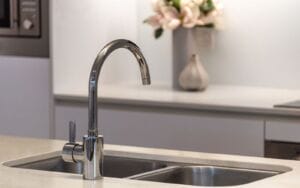An environmentally-friendly remodel is a life-changing undertaking, both for your personal health and the health of your home.
It involves a thorough assessment of toxic emissions from both inside and outside of the home and what can be done to lessen the home’s carbon footprint and any effects it has on the health of its inhabitants. Some of the process seems more obvious than others, such as conserving water, using energy-efficient lightbulbs and composting, but the journey to a truly green home is one of many steps and its success can be promised by a plethora of knowledge and expert advice.
Before you knock down walls, determine space for a new kitchen island or re-route wires, take a moment to absorb what the Valley’s top eco-remodeling experts have to say about an ecological overhaul and how to incorporate some of the best practices and products available.
Energy analysis
 For the first step, it is imperative to undergo an energy audit and a health and safety assessment, such as one offered by Advanced Energy Efficiency & Environmental Quality (AE3Q) in Mesa. AE3Q Certified Energy and Environmental Consultant Kirsten Shaw says that, “A home energy audit is the first step on the path toward a more satisfying renovation. Using a variety of state-of-the-art tools, we are able to identify the areas where your home is wasting energy and recommend the most cost-effective improvements for maximum comfort, minimum energy bills, optimal indoor air quality and building health and safety. Those key issues can be incorporated into your remodel so when you are enjoying your first shower in your new bathroom or preparing your first meal in your new kitchen, you are living in comfort as well as beauty.”
For the first step, it is imperative to undergo an energy audit and a health and safety assessment, such as one offered by Advanced Energy Efficiency & Environmental Quality (AE3Q) in Mesa. AE3Q Certified Energy and Environmental Consultant Kirsten Shaw says that, “A home energy audit is the first step on the path toward a more satisfying renovation. Using a variety of state-of-the-art tools, we are able to identify the areas where your home is wasting energy and recommend the most cost-effective improvements for maximum comfort, minimum energy bills, optimal indoor air quality and building health and safety. Those key issues can be incorporated into your remodel so when you are enjoying your first shower in your new bathroom or preparing your first meal in your new kitchen, you are living in comfort as well as beauty.”
An energy audit can not only guide the decision of which renovation to tackle first, but can it also unearth savings. After a company performs energy modeling based on the house’s data, the modeling will not only determine which improvements will reduce utility costs, but which projects will give you the greatest savings for the fewest dollars invested, says Shaw. An important note-to-self during this process: lowering utility bills is a matter of getting problem areas fixed correctly, which is a matter of hiring a contractor who understands and applies building science to improvements.
Water checks
Next, take measures to ensure your renovated home will save water on the inside as well as outside. The easiest way to establish water security is to select appliances and fixtures that are WaterSense labeled. While the Environmental Protection Agency shares much of this information, Shaw also has a few tips:
“Replacing the aerator on your bathroom sink faucet with a low-flow aerator and your showerhead with low-flow showerhead are two easy energy-saving and water-saving changes you can make,” she claims. “It takes a lot of energy to clean and distribute water, so whenever you save water, you are also saving energy.” Outside, she says that a key principle of water conservation is to keep as much rainwater in your yard as you can, as the most efficient yards have shade trees and low-water-use vegetation.
Seal the deal
A final precaution before demolition involves assuring or developing initiatives to certify that the home is cleanly and adequately ventilated. A sufficiently tight and subsequently ecologically healthy home is when outdoor air cannot leak in and indoor air cannot leak out. Shaw states that the most common locations of leaks are actually the attic and garage, which bring in dust, heat and other pollutants. “Tightening” a home improves indoor air quality by reducing dust and insulation fibers from the attic and any fumes, odors and carbon monoxide from the garage.
 “Making your home tight will also result in odors, stuffy air and a build-up of indoor air pollutants,” Shaw warns, which is why mechanical ventilation is a smart investment. “Mechanical ventilation exhausts moisture from showers and odors; also, ventilation brings in fresh air from outside. The best mechanical ventilation systems will bring in only as much outdoor air as is needed for good indoor air quality, but not too much, which will reduce the energy efficiency of the home.”
“Making your home tight will also result in odors, stuffy air and a build-up of indoor air pollutants,” Shaw warns, which is why mechanical ventilation is a smart investment. “Mechanical ventilation exhausts moisture from showers and odors; also, ventilation brings in fresh air from outside. The best mechanical ventilation systems will bring in only as much outdoor air as is needed for good indoor air quality, but not too much, which will reduce the energy efficiency of the home.”
Other holes, such as from piping and telephone lines, should always be sealed. Always seal electrical wire and light housings with fire-rated caulk or expanding spray foam, and do not ever, asserts Shaw, apply expanding spray foam directly to a light housing or other electrical structure that will get hot, even the fire-rated foams.
Remodel detox
The energy consultant also suggests detoxifying the remodel itself, “because there will always be odors associated with remodeling as most building materials and finishes, even VOC-free paints, have odors that need to be vented.”
VOCs, the toxic blend from which all ecological renovators steer deliberately away, are volatile organic compounds. VOCs are odorous, whether pleasant or repugnant, and all are highly damaging to animal bodies. Fortunately, while VOC’s can be found in almost any home building and renovation materials, places like Classy Kitchen & Bath in Chandler and Organic Living in Phoenix offer materials from flooring to cabinets that are sustainable, 100 percent natural, formaldehyde -and-VOC-free.
“We have both carpet and hard floorings that cater to the chemically sensitive person and therefore to everyone,” says Organic Living Founder Gerard Windstein. “Earth Weave and Nature’s Carpets, for example, are two brands whose carpets are (often) wool and are backed with a natural rubber adhesive. At standard places, wool carpet is usually backed with toxic glues. Always look for carpet that has zero ‘moth-proofing’ and stay away from semi-VOCs, both of which are designed to last the product’s lifetime. At that point, small children can ingest (the toxins) and they will get in your air.”
Natural, insoluble cork is a green option, and Windstein emphasizes the ecological and financial sustainability of bamboo, a wood that has the highest-rated hardness of any in the world — just pay attention to its age and installation. “Bamboo is only sustainable if it’s from mature trees and if it’s glued with formaldehyde-free adhesives. Cali-Bamboo is pre-cured, finished with ten coats, can be permanently glued to a floor or simply floated for easy removal; it has low toxicity and is good for fifty years.”
 Kitchen in focus
Kitchen in focus
When it comes to the kitchen and bath, avoiding products without formaldehyde and harmful VOCs can be difficult, as much engineered wood is rank with noxious chemicals that have been widely known to cause health problems like migraines and flu-like symptoms. Toxic-free cabinets can be found at Classy Kitchen & Bath in Chandler, where Chief Marketing Officer Bob LeSueur offers cabinets consisting of NAUF material, or No Added Urea Formaldehyde. “We use it often on various projects,” he says. “The boards are ‘certified’ to that specification.”
Finding ecological countertops is a much simpler search. Renovators have choices like cork, recycled glass, composite counters made from compressed paper and resin, bamboo, recycled aluminum and concrete or a concrete alternative, like quartz. “Granite countertops,” says Legacy Design Build Remodeling Vice President of Operations Stewart Truitt, C.R, “to the best of my knowledge are not treated with harsh chemicals during their harvest nor during the fabrication process. Once they are honed and polished they are sealed with a water-based sealant so that they can be eaten off of. It is not recommended to use cutlery directly on granite as it will cut in to the surface, which will allow food and germs to collect. As well, it is recommended to re-seal the granite every two years to ensure that it is still impervious to food and germs.”
Ecological expert Veronica Corney of Comfortable Surroundings Interior Designs, who suffers from Multiple Chemical Sensitivities, agrees, but says the concrete must be installed with no-VOC adhesives. Colors can be mineral-based pigments or aggregates such as corn, sunflowers or soybeans. Concrete is easy to clean with mild detergent and water, and can be sealed with linseed oil or beeswax, she says.
Furnishing the home
When selecting furniture, look for items made with natural materials and fillers, especially mattresses (typical mattresses are usually sealed with toxic, flame-retardant chemicals). Natural organic mattresses can be found at IKEA and Copenhagen Furniture stores. “Wool, organic cotton, or natural latex mattresses do not off-gas like synthetic materials do,” says Corney. “This is especially important for people with chemical sensitivities since many hours are spent each night inhaling these toxins. Formaldehyde is sometimes used on sheets as a wrinkle-resistant finish. Organic cotton or bamboo sheets are a much better alternative.”
Near the end of an ecological overhaul, especially in the desert, there is a final detail to check. Air ducts that distribute conditioned air around the house are typically mechanically fastened to the duct register, but not air sealed. Says Shaw, “Air will easily leak into or out of the duct connections. Also, if your home has a furnace sitting on a return air plenum, the plenums are typically leaky and uninsulated. That is especially a problem if your furnace is in your garage. You don’t want the pollutants from the paints, pesticides and gasoline that is stored in your garage being sucked into your conditioned air every time the AC or heat comes on.”
The steps to a truly green home may seem as numerous as the benefits such an overhaul can provide in your life and the life of your home, but really, the positive effects outlast the work. Even before any of these steps have been taken, a professional consultation is necessary; every family has specific health needs and desires, and no two homes are the same. Educate yourself about VOCs and brands; some VOCS, according to Windstein, are 100 percent natural and some are 120 percent man-made. Hit the problem, not the source, he advises, and your remodel will be successful.




